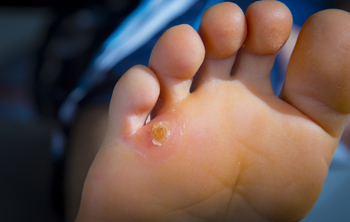
Corns on the feet can stem from various factors, with age being one of them. As people grow older, their feet undergo physical and biomechanical changes. These can affect how they function and alter the way you walk, potentially leading to corns. WearingiIll-fitting socks can also contribute to corns on the feet. Too large socks may slip and cause friction, while tight socks can irritate the skin. Shoes that do not fit properly, especially high-heeled or narrow shoes, whether too big or too small, can cause friction and pressure, causing a corn to develop. Obesity can alter your gait and weight distribution, often resulting in foot deformities like flat feet, which in turn make corns more likely to develop. Hammertoes or bunions exert unusual pressure on parts of the foot, promoting corn formation. A podiatrist can treat a foot corn by trimming the skin with a sharp tool to remove the outer layers of the corn. Another option is corn reduction, which calls for cutting away excess bone, repositioning larger bones, or attaching joints. In some cases, a cortisone injection directly into the corn can provide significant relief. If you are suffering from the pain of corns on the feet, it is suggested that you schedule an appointment with a podiatrist.
Corns can make walking very painful and should be treated immediately. If you have questions regarding your feet and ankles, contact one of our podiatrists of Omega Podiatry. Our doctors will treat your foot and ankle needs.
Corns: What Are They? And How Do You Get Rid of Them?
Corns are thickened areas on the skin that can become painful. They are caused by excessive pressure and friction on the skin. Corns press into the deeper layers of the skin and are usually round in shape.
Ways to Prevent Corns
There are many ways to get rid of painful corns such as:
- Wearing properly fitting shoes that have been measured by a professional
- Wearing shoes that are not sharply pointed or have high heels
- Wearing only shoes that offer support
Treating Corns
Although most corns slowly disappear when the friction or pressure stops, this isn’t always the case. Consult with your podiatrist to determine the best treatment option for your case of corns.
If you have any questions please feel free to contact our offices located in Los Angeles, Huntington Park, and Reseda, CA . We offer the newest diagnostic and treatment technologies for all your foot and ankle needs.
